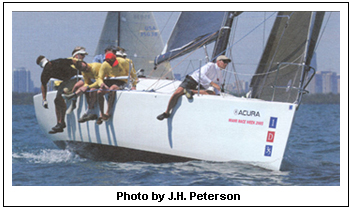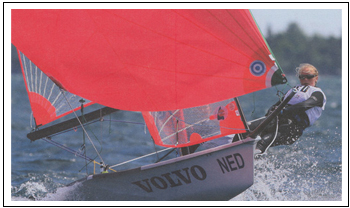| Boatspeed
IQ Test
Evaluate your speed ‘smarts’!
by David Dellenbaugh
General
Sail Trim
| 1. When
you want to point higher, a tighetr leech
is usually better than an open leech |
| |
T
F |
| 2.
A deep sail creates more drag than
a flat one. |
|
T
F |
3. Which of the following may
require that you trim your sails differently from
tack to tack?
a) the presence of cross-current
b) an improperly tuned rig
c) the existence of wind sheer
d) waves not aligned with wind
4. In which wind/sea condition
would you want the least amount of twist in your
sails?
a) moderate air and flat water
b) heavy air and slight chop
c) light air and lump
5. Which of the following does
not indicate the possible presence of wind sheer
aloft?
A difference from tack to tack in
a) apparent wind angle
b) boatspeed
c) sail trim or sail behavior
d) true wind direction.
6. Which of these is the least
effective in depowering your main?
a) ease the sheet to increase twist
b) increase vang tension
c) add more backstay tension
d) pull harder on the cunningham
7. Which of the following is
a good time for trimming your sails on the tight
side when sailing upwind?
a) inexperienced helmsperson
b) the wind is shifty
c) the seas are lumpy
d) you are almost overpowered
| 8.
In choppy conditions you should generally
sail with more twist in your sails |
|
T
F |
| 9.
The reason why sails need twist on
both tacks is because of wind sheer aloft. |
|
T
F |
| 10.
Trimming a sail tighter is one way to increase
the amount of its lift, or power |
|
T
F |
Boat Trim and Steering
11. When you’re having
trouble finding the “groove”, which
of the following are good ideas?
a) ease the jib sheet slightly
b) tighten the backstay
c) bear off a couple of degrees
d) trim your mainsheet a little
12. When you are about to hit
a couple of bad waves, which of the following
is not a good idea?
a) bear off a couple of degrees
b) add some twist to your sails
c) move your weight forward a bit
d) ease your sheets slightly
| 13.
You are permitted to move your body
to help steer the boat through waves. |
|
T
F |
14. How many degrees of windward
helm do you usually want when you're sailing upwind?
a) 0°
b) 4°
c) 8°
d) 12°
15. When sailing upwind, which
of these should be the lowest priority for the
helmsperson?
a) looking at the jib telltales
b) watching speed of other boats
c) watching the boatspeed display
d) looking at waves ahead
| 16.
More leeward heel increases windward helm |
|
T
F |
17. Which of the following will
not reduce windward helm?
a) flatten your mainsail shape
b) move the centerboard forward
c) reduce the angle of heel
d) slide crew weight forward
18. You don’t want the
front of your jib to be rounder when;
a) the helm can’t find the groove
b) you need to accelerate
c) you’re having trouble pointing
d) you are about to hit waves
19. When you get a “velocity
header” you should usually:
a) bear off immediately to fill jib
b) sail straight until your speed
drops a little -then bear off
c) head up slightly and trim sails
d) none of the above

Rig Tuning
20. Which of the following things
might you do to increase the amount of pre-bend
in your mast?
a) move the mast butt forward
b) move mast forward at the deck
c) angle your spreaders aft
d) tighten the lower shrouds
21.
If possible, you should always tune your rig
so the mast is perfectly straight from side
to side on both
tacks. |
|
T
F |
| 22.
One good method for gauging how much rake
you have is to measure the length of your
forestay. |
|
T
F |
| 23.
If you cannot trim your sails identically
on each tack, your rig is not tuned correctly.
|
|
T
F |
| 24.
The primary way to get more rake is by pulling
harder on your backstay or runners. |
|
T
F |
25. If you have large overbend
wrinkles extending from the mainsail clew toward
the mast, you might consider:
a) easing the runner or backstay
b) tightening the boom vang
c) loosening the cunningham
d) moving mast aft at the deck
Spinnaker Trim
| 26.
Trim the spinnaker sheet hard enough to keep
the sail from curling along the luff. |
|
T
F |
| 27.
If you are reaching and you want less power
in the spinnaker, lower the outboard end of
the pole. |
|
T
F |
28. Which of the following is not
a good guideline for setting the height of your
spinnaker pole?
a) both clews are level
b) the luff of the chute rises vertically from the
pole’s outer end
c) luff curls evenly top to bottom
d) the center seam of the sail angles to leeward
| 29.
You should not let your mast go farther forward
than vertical when racing downwind. |
|
T
F |
| 30.
Acenterline sprit pole should be fully extended
whenever the spinnaker is set. |
|
T
F |
| 31.
When running in breeze, the tack line of an
asymmetrical chute should rise vertically
from the outer end of the sprit pole |
|
T
F |
| 32.
The tack of an asymmetrical chute should be
pulled down to the end of the sprit. |
|
T
F |
| 33.
It is permissible to fly your spinnaker without
a pole for the entire run |
|
T
F |
| 34.
You are allowed to pump the spinnaker sheet
to promote surfing or planing. |
|
T
F |
35. On a heavy-air run, which
of the following are not ways to gain more control?
a) ease your vang tension a little
b) sail a slightly higher angle
c) over-trim your chute slightly
d) lower your centerboard a bit
e) move crew weight forward
Jib and Genoa Trim
| 36.
A tighter backstay makes your headsail flatter.
|
|
T
F |
| 37.
If the leeward luff telltales are stalled,
you should either ease the jib sheet or try
bearing off a little. |
|
T
F |
| 38.
In a typical headsail, how far aft should
the position of maximum draft normally be? |
|
T
F |
| 39.
When you want to point higher, one of the
first things you should try is trimming your
jib sheet tighter. |
|
T
F |
40. You should set the fore-and
aft position of your headsail lead so that:
a) the front of your sail luffs evenly from top
to bottom;
b) your luff telltales break evenly from top to
bottom;
c) The sail’s foot and leech reach maximum
trim at the same time.
| 41.
On most boats, you should tension the luff
of your jib or genoa until you eliminate all
the wrinkles. |
|
T
F |
| 42.
You can usually point higher by pulling harder
on the jib luff btension. |
|
T
F |
| 43.
If you add more pre-bend, you will usually
be able to sail with a fuller headsail. |
|
T
F |
| 44.
The primary way for a jib trimmer to “change
gears” is by moving the lead position.
|
|
T
F |
Mainsail Trim
| 45.
When you ease the backstay, this moves the
draft in the main farther forward. |
|
T
F |
| 46.
You should almost never position your traveler
car above (to windward of) the centerline
of the boat. |
|
T
F |
47. When you loosen your cunningham
control line:
a) the mainsail draft moves aft
b) the mainsail gets flatter overall
c) both of the above
d) neither of the above
| 46.
The primary reason for tensioning the cunningham
is to get rid of wrinkles in the lower part
of the mainsail. |
|
T
F |
47. When you loosen your cunningham
control line:
a) the mainsail draft moves aft
b) the mainsail gets flatter overall
c) both of the above
d) neither of the above
| 48..
48The primary reason for tensioning the cunningham
is to get rid of wrinkles in the lower part
of the mainsail. |
|
T
F |
49. The telltale on your top
batten should normally be stalling about half
the time in:
a) light air and chop
b) flat water and medium breeze
c) survival conditions
| 50..
In most conditions, a good rule of thumb is
to trim your main so the top batten is parallel
to the boom, both upwind and when you’re
running. |
|
T
F |
| 51..
When you ease the outhaul, it closes the lower
leech an increases windward helm. |
|
T
F |
| 52..
You should always keep the mainsail at maximum
hoist with the top of the headboard at the
black band. |
|
T
F |
| 53..
Telltales on the main don’t help much
on a run, so ease the sheet until the main
just starts to luff near the mast. |
|
T
F |
54. You normally need to use
a lot of cunningham for:
a) a new mainsail
b) an older mainsail
c) light-air conditions
d) heavy-air conditions
55. In a mainsail, how far aft
(distance from luff to leech) should the position
of maximum draft normally be?
a) 35-40%
b) 45-50%
c) 55-60%
56. Which of the following will
not help reduce excessive backwind in the main?
a) move the jib lead outboard
b) tighten the backstay
c) ease jib luff tension
d) trim the mainsheet harder

Boat Performance
| 57.
On a beat, you should try to go
for speed first and then work on pointing.
|
|
T
F |
| 58.
You should never heel to windward upwind. |
|
T
F |
59.
59An upwind “target” is the boatspeed
that will give you maximumVMG to windward
in the existing
wind velocity. |
|
T
F |
60. In light air you often move
crew forward on a run to:
a) reduce wetted surface
b) increase windward helm
c) let the chute fly farther away
d) make the boat more stable
61. The most accurate way to
gauge how well you are performing upwind is to:
a) watch your knotmeter
b) monitor your VMG readout
c) compare speed to nearby boats
d) use your sense of feel
Answers
1. True 2. True 3. B, C, D 4. A 5. D 6. B 7. D
8. True 9. False 10. True 11. A, C 12. C 13. True
14. B 15. B 16. True 17. B, D 18. C 19. B 20.
B,C 21. False 22. True 23. False 24. False 25.
A, D 26. False 27. True 28. D 29. False 30. True
31. False 32. False 33. True 34. True 35. A, E
36. True 37. False 38. B 39. False 40. A, B, C
41. False 42. False 43. True 44. False 45. True
46. False 47. A 48. False 49. B 50. True 51. True
52. False 53. True 54. B,D 55.B 56. C 57. True
58 .False 59. True 60. A,C 61. C
TOP/images/top.jpg)
|


